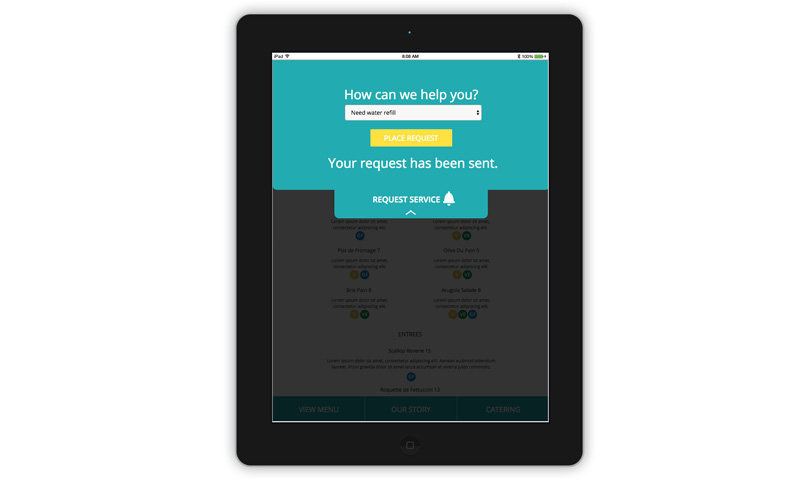The Challenge
A local non-profit and sit-down style restaurant seeks to employ and train under-privileged people and develop an app that would save on labor cost by minimizing interactions at tables and number of employees. Communicating their story and mission was important as well as displaying a rotating menu. The menu needed to be editable to display current theme and detailed information about ingredients. Patrons would be able to request service from the app that would notify the server. The business wished to let customers drive their own dining experience by using the app on their phones to participate in a loyalty program, filter the menu based on dietary needs, order food, and pay their bill independently.
The Discovery
User research uncovered interesting and complicated information regarding customer and server needs and expectations of service and experience in restaurants. Some discoveries informed our decisions to eliminate features that the client initially wanted to include but that would contradict user needs. Other discoveries revealed that the business might need to use the data we had collected to revisit their business model and pivot on a number of things to ensure success of the restaurant and viability of integrating an app like this. In addition, research could not confirm that the creation of the app would save on cost in the long run.
The Solution
After careful consideration, my team and I worked with the client to pin down a MVP that did not contradict user needs. The result was a designed customer facing side to the app, as well as an admin facing side. Due to the 3 week time constraint and the revelations of our user research contradicting many of the initial goals of the app, success could not be guaranteed. Also the nature of this pro bono project serving also as a class assignment, inevitably influenced the way we approached the project. Through research, we ultimately discovered valuable information that provoked the need for important business considerations and explored possible sucessful routes with the client.
Research
Research began with exploring the domain. Since the restaurant was not yet functioning, we needed to gather as much information as we could to understand the context and who we were designing for. We looked at a successful local business with a similar business model, restaurants that integrate technology on the customer side, POS system capabilities, and spoke with our client about their business goals.
We quickly realized that our application would need 2 sides, one for the customer and one for the admin or server. We produced 2 scripts, one for restaurant workers and one for potential patrons with a similar mission and began conducting user interviews.
Plan
Through a concept mapping exercise, we were able to more clearly define relationships and hierarchy and organize information. Affinity diagraming helped us sort out key points gathered in our interview process, which lead to the formation of our personas.
Testing
Our usability tests revealed some areas of confusion and ways we could improve our initial designs. For example, in the adjacent images, you can see the evolution of our menu editing page for the administrative side of the app. In addition, the meaning of the white circles with numbers indicating table requests were unclear to most users so we opted to use the bell icon that correlates with the icon on the customer side of the app and provided more meaning.
Design
My team and I felt very passionate about the non-profit’s mission and success. We ultimately recommended that our client not develop this app. This project was challenging but also demonstrated the great value in conducting user research. In addition, our prototypes shows our ability to create successful interaction and adhere to pre-existing brand guidelines.
Because the non-profit had limited funding, a tailorable out of the box POS system was suggested as an option. We also recommended considering a business model with a less formal dining experience that might change customer’s service expectations and provide a way for technology to be harmoniously integrated. A last and fun idea was integrating an analog solution to making service requests from tables via buttons and a light system.











